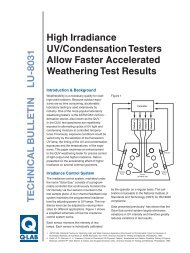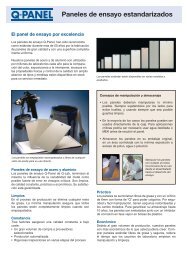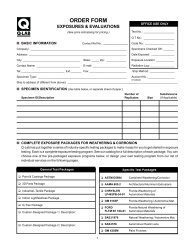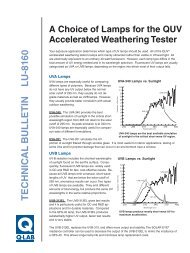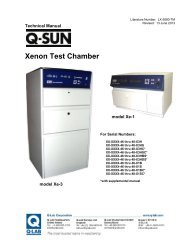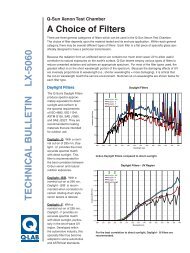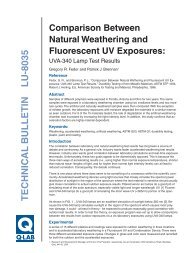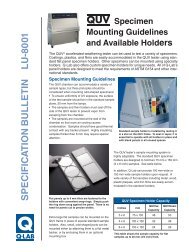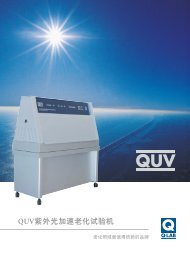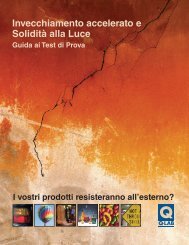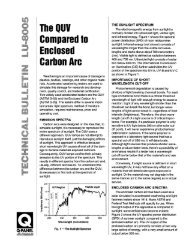Q-FOG Cyclic Corrosion Testers - Q-Lab
Q-FOG Cyclic Corrosion Testers - Q-Lab
Q-FOG Cyclic Corrosion Testers - Q-Lab
Create successful ePaper yourself
Turn your PDF publications into a flip-book with our unique Google optimized e-Paper software.
www.q-lab.com<br />
Q-<strong>FOG</strong> <strong>Cyclic</strong> <strong>Corrosion</strong> <strong>Testers</strong><br />
A More Realistic Salt Spray
2<br />
<strong>Cyclic</strong> <strong>Corrosion</strong> <strong>Testers</strong><br />
• Improve correlation with outdoor results<br />
• Perform sophisticated cyclic corrosion<br />
tests<br />
• Perform Prohesion ® or traditional salt<br />
spray exposures<br />
• Conform to ISO,ASTM, BS, DIN, automotive<br />
and industrial specifications<br />
<strong>Cyclic</strong> <strong>Corrosion</strong> Tests<br />
<strong>Cyclic</strong> corrosion testing provides the best<br />
possible laboratory simulation of natural corrosion.<br />
Current research indicates that test results<br />
are similar to outdoors in resulting structure,<br />
morphology, and relative corrosion rates. Prior<br />
to cyclic testing, conventional salt spray (a<br />
continuous salt spray at 35˚C) was the standard<br />
way to simulate corrosion in a lab. Because<br />
conventional salt spray methods failed to mimic<br />
Features<br />
the natural wet/dry cycles of the outdoors, test<br />
results frequently provided poor correlation to<br />
outdoors.<br />
In a Q-<strong>FOG</strong> ® <strong>Cyclic</strong> <strong>Corrosion</strong> Tester, specimens<br />
are exposed to a series of different environments<br />
in a repetitive cycle that mimics the outdoors.<br />
Simple cycles, such as Prohesion, may consist of<br />
cycling between salt fog and dry conditions.<br />
More sophisticated automotive methods may call<br />
for multi-step cycles that incorporate humidity or<br />
condensation, along with salt spray and dry-off.<br />
Within one Q-<strong>FOG</strong> chamber, it is possible to cycle<br />
through all of the most significant corrosion environments.<br />
Even the most complex test cycles can<br />
easily be programmed with the custom designed<br />
Q-<strong>FOG</strong> controller.<br />
Q-<strong>FOG</strong> chambers are available in two types.<br />
Model SSP performs traditional salt spray and<br />
Prohesion tests. Model CCT performs salt spray,<br />
Prohesion, and most cyclic automotive tests. See<br />
the Q-<strong>FOG</strong> Specifications Bulletin (LF-8110) for a<br />
detailed list of test methods. Q-<strong>FOG</strong> chambers are<br />
available in two sizes to fulfill a range of testing<br />
requirements.<br />
Model Number: SSP 600 SSP 1100 CCT 600 CCT 1100<br />
Chamber Volume<br />
Liters<br />
Sample Capacity:<br />
4" x 12" Panels (100 x 300mm)<br />
3" x 6" Panels (75 x 150mm)<br />
Sample Space:<br />
Length<br />
Width<br />
Height (not including lid)<br />
Height (including lid)<br />
640 1103 640 1103<br />
128<br />
160<br />
42.9" (1090mm)<br />
25.8" (655mm)<br />
18.0" (457mm)<br />
28.5" (655mm)<br />
200<br />
240<br />
57.4" (1458mm)<br />
32.1" (815mm)<br />
18.0" (457mm)<br />
30.5" (775mm)<br />
128<br />
160<br />
42.9" (1090mm)<br />
25.8" (655mm)<br />
18.0" (457mm)<br />
28.5" (655mm)<br />
200<br />
240<br />
57.4" (1458mm)<br />
32.1" (815mm)<br />
18.0" (457mm)<br />
30.5" (775mm)<br />
Salt Fog<br />
Ambient to 60° C<br />
• • • •<br />
Dry-Off (forced air)<br />
Ambient to 70° C • • • •<br />
Dwell (no action)<br />
Ambient to 60° C<br />
• • • •<br />
100% Humidity<br />
45° C to 60° C<br />
• •<br />
Visual Monitoring<br />
via Window & Light • •
Q-<strong>FOG</strong> chambers are available in two sizes to fulfill a wide range of testing requirements.<br />
Model SSP for Prohesion or<br />
Conventional Salt Spray<br />
Numerous accelerated corrosion tests may<br />
be performed in Q-<strong>FOG</strong> model SSP, including<br />
Prohesion, ASTM B117, ASTM G85, BS 3900<br />
F4 & F9, DIN 50.021 and ISO 9227.<br />
Prohesion. This test uses fast cycling, rapid temperature<br />
changes, a low humidity dry-off cycle and<br />
a different corrosive solution to provide a more<br />
realistic test. Many researchers have found this<br />
test useful for industrial maintenance coatings.<br />
Conventional Salt Spray. Continuous salt spray<br />
exposures are widely specified for testing components<br />
and coatings for corrosion resistance.<br />
Applications include plated and painted finishes;<br />
aerospace and military components; electrical and<br />
electronic systems.<br />
Most of these tests are performed to particular<br />
specifications such as ASTM B117 (Salt Spray),<br />
and BS 3900 F4. These tests are widely used<br />
for relative corrosion testing. They are typically<br />
run at an elevated temperature and do not<br />
incorporate a dry-off cycle. They require heated,<br />
humidified air for the spray.<br />
Model CCT for <strong>Corrosion</strong> Research<br />
and <strong>Cyclic</strong> Automotive Tests<br />
The Q-<strong>FOG</strong> model CCT has all the advantages of<br />
the model SSP, but adds the flexibility of including<br />
100% humidity, another critical exposure<br />
condition, to your cyclic corrosion test.<br />
<strong>Cyclic</strong> Automotive Tests. Today’s automotive<br />
corrosion test methods typically call for exposing<br />
specimens to a repetitive cycle of salt spray,<br />
high humidity, low humidity dry-off, and ambient<br />
conditions. These test methods were originally<br />
developed as labor intensive manual procedures.<br />
The multi-functional Q-<strong>FOG</strong> Model CCT is designed<br />
to perform these cyclic tests automatically<br />
in a single chamber. CCT advantages include:<br />
• Eliminates manual moving of test<br />
specimens from one chamber to another<br />
• Eliminates laborious spraying of test<br />
specimens<br />
• Eliminates variability in results from<br />
excessive specimen handling<br />
CCT units come equipped with a viewing window<br />
in the side of the lid and an internal light to allow<br />
easy monitoring of the test conditions.<br />
3<br />
3
4<br />
Simple, straight forward operation; test status<br />
and diagnostics continuously displayed.<br />
Q-<strong>FOG</strong> Chamber Design Benefits<br />
Easy Programming. The Q-<strong>FOG</strong> model CCT is<br />
designed to cycle between four conditions: Fog,<br />
Dry-Off, 100% Humidity, and Dwell. The conditions,<br />
time and temperature are controlled by a<br />
user-friendly, built-in microprocessor. Interactive<br />
software allows easy user programming and operation.<br />
The operator can quickly create new cycles,<br />
or run any of the programmed cycles. A test timer<br />
can be set to sound an alarm or terminate a test.<br />
The controller continuously displays test conditions<br />
and the progress of the test.<br />
The Q-<strong>FOG</strong> controller is designed to be both<br />
functional and easy to use; it includes complete<br />
self-diagnostic error checking.<br />
The controller constantly monitors the status and<br />
performance of all systems. It also displays simple<br />
warning messages, routine service reminders or<br />
performance safety shutdown, as needed.<br />
Every Q-<strong>FOG</strong> chamber allows the convenient<br />
storage of 10 pre-programmed test cycles. Built in<br />
comprised data logging ensures a quick and easy<br />
connection between your Q-<strong>FOG</strong> machine and a<br />
PC or LAN.<br />
Automatic Data Logging:<br />
• Simple data collection<br />
• Direct transfer of data from the Q-<strong>FOG</strong><br />
chamber to your computer.<br />
• Automatically records exposure conditions<br />
• Easily connects to your PC or LAN<br />
• Conveniently records in either graphical<br />
or digital format<br />
Easy Maintenance. Direct access to control<br />
components is possible with a removable side<br />
panel. All components in a Q-<strong>FOG</strong> tester are<br />
positioned to allow easy access for inspection and<br />
maintenance.<br />
Hanging rods allow mounting of parts and odd<br />
shaped test specimens.<br />
Easy Sample Mounting. The Q-<strong>FOG</strong> chamber<br />
has a low belt line and an easy opening lid for<br />
easy sample mounting.<br />
Self-Diagnostics. The Q-<strong>FOG</strong> controller includes<br />
complete self-diagnostics, including warning messages,<br />
routine service reminders and safety shut<br />
down.<br />
Removable side panel for easy access to bubble<br />
tower and other components.
Precise Control of Fog Dispersion. The Q-<strong>FOG</strong><br />
tester has superior fog dispersion compared to<br />
conventional systems which cannot vary volume<br />
and distance independently. A variable speed<br />
peristaltic pump controls the amount of corrosive<br />
solution delivered to the spray atomizer, while the<br />
air pressure regulator controls the distance of the<br />
“throw.”<br />
Reinforced Plastic Construction. In a Q-<strong>FOG</strong><br />
test chamber, there is nothing to corrode and nothing<br />
to contaminate your test specimen. Q-<strong>FOG</strong><br />
testers are made of solid, fiber-reinforced plastic.<br />
The robust, heavy wall chamber and lid have low<br />
thermal conductivity for efficient, precise temperature<br />
control. The heat resistant resins allow testing<br />
at higher temperatures than competitive cabinets.<br />
Internal Solution Reservoir. Space utilization is<br />
maximized and maintenance is minimized with the<br />
Q-<strong>FOG</strong> machine's internal solution reservoir. The<br />
120 liter reservoir has enough capacity for running<br />
most tests for 7 days or more. The reservoir has<br />
an integral salt filter and a built-in alarm to alert<br />
the operator when the solution is low.<br />
Fast Cycling. Q-<strong>FOG</strong> testers can change<br />
temperatures exceptionally fast because of their<br />
unique internal chamber heater and their high volume<br />
cooling/dry-off blower. An additional air heater<br />
allows very low humidity dry-off exposures.<br />
Conventional chambers with water jackets cannot<br />
cycle rapidly because of the thermal mass of the<br />
water, nor can they produce low humidity.<br />
Components are easy to remove for periodic<br />
maintenance.<br />
Q-<strong>FOG</strong> Bubble Tower<br />
Safety. All electrical circuits have both conventional<br />
circuit breakers and a Ground Fault Interrupter<br />
(Residual Current Device). All heaters have<br />
both electronic and mechanical over-temperature<br />
protection. The cabinet is made of a fire-resistant<br />
resin.<br />
Remarkably Low Price. The Q-<strong>FOG</strong> machine<br />
offers state of the art corrosion testing technology,<br />
reliability, ease of operation and easy maintenance<br />
– all at a remarkably affordable price.<br />
Flow meter shows the<br />
precise solution flow<br />
rate as regulated by<br />
the pump. This allows<br />
precise control of the<br />
amount of fog produced.<br />
During Fog Function, the<br />
spray air pressure controls<br />
the distance of the "throw"<br />
of the fog.<br />
5<br />
5
6<br />
<strong>Cyclic</strong> <strong>Corrosion</strong> <strong>Testers</strong>:<br />
How They Work<br />
<strong>Cyclic</strong> corrosion tests expose specimens to a series of different environments in a repetitive cycle.<br />
Simple tests may consist of cycling between two conditions: fog and dry. More sophisticated procedures,<br />
such as automotive, call for multi-step cycles incorporating humidity or condensation, along with salt fog<br />
and dry-off. With the Q-<strong>FOG</strong> <strong>Cyclic</strong> <strong>Corrosion</strong> Tester, you can cycle through all these environments in<br />
one chamber. And, with the custom controller, you can easily program complex test cycles or run any of<br />
the pre-programmed procedures.<br />
Fog Function<br />
During the Fog Function, the<br />
corrosion tester typically operates as<br />
a conventional salt spray.<br />
• Corrosive solution from the<br />
internal reservoir is pumped to<br />
the nozzle.<br />
• Compressed air is humidified<br />
by passing through the bubble<br />
tower on its way to the nozzle<br />
(except for Prohesion tests).<br />
• Nozzle atomizes solution air into<br />
a corrosive fog.<br />
• Chamber heaters maintain<br />
the programmed chamber<br />
temperature.<br />
Dry-off Function<br />
During the Dry-off Function, a purge<br />
blower forces room air over an air<br />
heater and into the chamber. This<br />
creates a low humidity condition<br />
inside the chamber. The chamber<br />
temperature is controlled by the<br />
chamber heaters and the air heater.<br />
Humidity Function<br />
During the Humidity Function, the<br />
chamber is maintained at 100%<br />
relative humidity by forcing hot water<br />
vapor into the chamber. The vapor<br />
generator heater maintains the<br />
programmed chamber temperature.<br />
The Humidity Function is available<br />
on model CCT only.<br />
Solution<br />
Reservoir<br />
Lid<br />
Chamber<br />
Heater<br />
Diffuser<br />
Specimens<br />
Vent<br />
Spray<br />
Nozzle<br />
Pump<br />
Bubble<br />
Tower<br />
Solution<br />
To Pump<br />
Air Heater<br />
Blower<br />
Vapor<br />
Generator<br />
Controller<br />
Compressed<br />
Air In<br />
D.I.<br />
Water In
UV Exposure Improves<br />
<strong>Lab</strong>oratory <strong>Corrosion</strong><br />
Correlation<br />
While both the QUV and the Q-<strong>FOG</strong> testers<br />
have outstanding advantages on their own,<br />
when used together they are revolutionizing<br />
corrosion testing. Ultraviolet light stability of a<br />
coating can be a major factor in its corrosion<br />
resistance. Degradation and corrosion that<br />
occurs in natural environments can be better<br />
simulated by incorporating UV/weathering<br />
factors into a wet/dry cyclic corrosion test.<br />
Research indicates that a corrosion cycle<br />
alternating between 1 week (168 hours) in a<br />
QUV Accelerated Weathering Tester and 200<br />
hours in a cyclic corrosion tester can give<br />
more realistic results than either CCT alone, or<br />
conventional salt spray.<br />
The guidelines for combination Q-<strong>FOG</strong>/QUV<br />
machine testing can be found in ASTM D5894,<br />
"Standard Practice for <strong>Cyclic</strong> Salt Fog/UV<br />
Exposure of Painted Metals."<br />
Q-<strong>FOG</strong> Benefits<br />
• Improve correlation with<br />
outdoor results<br />
• Perform sophisticated cyclic<br />
corrosion tests<br />
• Perform Prohesion or traditional<br />
salt spray exposures<br />
• Conform to ISO, ASTM, BS, DIN,<br />
automotive and industrial specifications<br />
<strong>Cyclic</strong> <strong>Corrosion</strong> <strong>Testers</strong><br />
Improve correlation<br />
to outdoor<br />
results by using<br />
the Q-<strong>FOG</strong> and<br />
QUV testers<br />
as specified in<br />
ASTM D5894.<br />
• Easy sample mounting<br />
• Greater programming flexibility<br />
• Rapid temperature cycling<br />
The QUV/se tester<br />
features SOLAR EYE ®<br />
irradiance control for<br />
precise maintenance<br />
of UV light.<br />
• All-plastic construction for maximum<br />
corrosion resistance<br />
7<br />
7
Q-<strong>Lab</strong> Corporation www.q-lab.com<br />
Q-<strong>Lab</strong> Headquarters<br />
Westlake, OH USA<br />
Tel: +1-440-835-8700<br />
info@q-lab.com<br />
Q-<strong>Lab</strong> Florida<br />
Homestead, FL USA<br />
Tel: +1-305-245-5600<br />
q-lab@q-lab.com<br />
Q-<strong>Lab</strong> Europe, Ltd.<br />
Bolton, England<br />
Tel: +44-1204-861616<br />
info.eu@q-lab.com<br />
Q-<strong>Lab</strong> Arizona<br />
Buckeye, AZ USA<br />
Tel: +1-623-386-5140<br />
q-lab@q-lab.com<br />
Q-<strong>Lab</strong> Deutschland, GmbH<br />
Saarbrücken, Germany<br />
Tel: +49-681-857470<br />
vertrieb@q-lab.com<br />
Q-<strong>Lab</strong> China 中国代表处<br />
Shanghai, China 中国上海<br />
电话: +86-21-5879-7970<br />
info.cn@q-lab.com<br />
LF-8101.4 © 2011 Q-<strong>Lab</strong> Corporation. All Rights Reserved.<br />
Q-<strong>Lab</strong>, the Q-<strong>Lab</strong> logo, Q-<strong>FOG</strong>, and SOLAR EYE are registered trademarks of Q-<strong>Lab</strong> Corporation. Prohesion is an<br />
exclusive trademark of Croda Mebon Ltd.



